| Kenchoji Temple" (建長寺) |
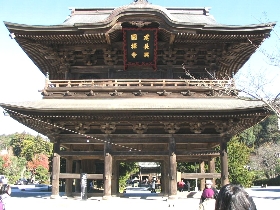
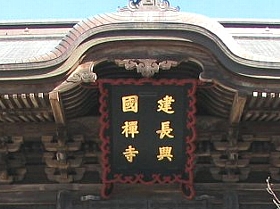
Full name: Kofukusan (巨福山) Kenchoji
Denomination: Rinzai sect (臨済宗)
Location: One kilometer south of Kita-Kamakura Station
History: Before the temple was built, this valley site was an execution ground known as Jigokudani (地獄谷), literally, Hell Valley. A Jizodo Hall (地蔵堂) once stood on the execution site but the structure was moved to Sankeien Park (三渓園) in Yokohama and its statue of Jizo is now in the Butsuden Hall in the center of the grounds.
In 1253, Hojo Tokiyori (北条時頼, 1227-63) had Kenchoji temple built, inviting Rankei Doryu (蘭渓道隆, 1213-78) as the founding priest. This was around 30 years prior to the completion of Engakuji temple. The structures and their layout were modeled after a Chinese Zen monastery. The temple became the first Zen center in Japan and was the first to be officially designated a Zen temple.
Rankei Doryu came from China in 1246. Prior to the temple's construction, he stayed first at Jufukuji (寿福寺), then at Jorakuji (常楽寺), and became the founding priest of Kenchoji upon its completion. He enforced strict discipline based on Chinese Zen teachings and established the temple as one of the central facilities of Zen practice. Later, he moved to Kenninji (建仁寺) in Kyoto and died in 1278 at the age of 66.
After his death, he was given the posthumous title, Daikaku Zenji (大覚禅師). This title, literally "Zen Master," was the first to be bestowed by an emperor on a Zen priest. Later, it became customary to grant the title Zenji (禅師) to Zen priests who were sufficiently esteemed, learned and virtuous. Other high-ranking priests succeeded to the position, including Gottan Funei (兀菴普寧, ?-1276), the second Chief Priest, and Mugaku Sogen, the fifth Chief Priest.
In the last years of the Kamakura period, the Somon Gate, Sammon Gate, Butsuden Hall, and Hatto Hall stood in a straight line in the Chinese Zen temple style. There were one thousand priests, monks, and workers, and the sub-temples numbered forty-nine. Even after the Kamakura bakufu (幕府) was overthrown, the temple was patronized by the Ashikaga and prospered as the head temple among the Five temple System of Zen monasteries. Kenchoji once lost its prosperity in the Edo period, but nowadays it is regarded as the best exam="all" of the Zen style in Kamakura.
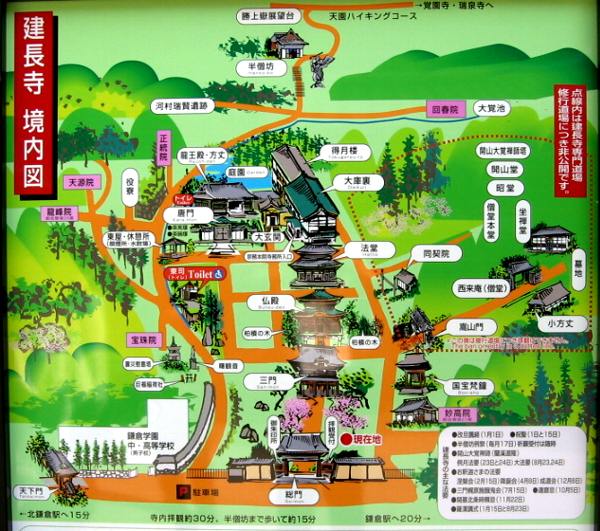
Grounds and structures: The temple entry is through the Nishi-Gemon Gate (西外門), literally West Outer Gate. The characters on the overhead plaque read "Tenka Zenrin" (天下禅林). "Tenka" means "the world" or "the whole country" and "Zenrin" means "Zen temple." Beyond this West gate is the Somon Gate (総門), also with a plaque. The inscription here is "巨福山," Kofukusan. (The character "巨" contains an unusual stoke "、" , difficult to show here. It is called "hyakkan-ten (百貫点), meaning a stroke that adds value to the character. With this added stroke, the character is said to gain in dignity.)
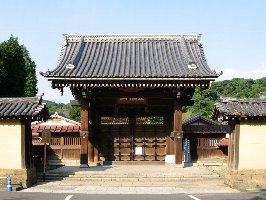
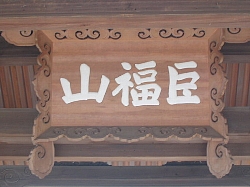
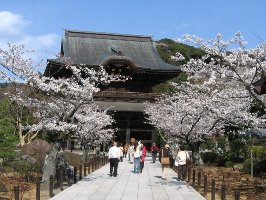

The massive Sammon Gate lies beyond the Somon Gate. It is in the nijumon-style (二重門, a two-storied gate with double roofs) and was built in 1775. On the second story are statues of Gohyaku Rakan (五百羅漢, Five-hundred Arhats).
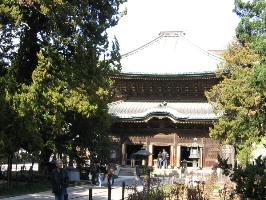
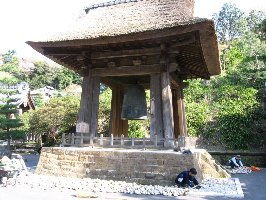
The approach beyond the gate is lined with junipers (byakushin, 柏槙or shariju, 舎利樹), said to have been brought here from China by Rankei Doryu, the founding priest of Kenchoji. Even now, these old trees and the setting are reminders of what a Zen temple garden must have been like 700 years ago.
A belfry stands to the right of the Sammon Gate. The large bell, designated a National Treasure, was made in 1255 through a donation from Hojo Tokiyori. Though the bell ranks second in size to the one at Engakuji, its workmanship is reputedly to be just as fine in its shape, carving and inscriptions. The bell was cast by Mononobe Shigemitsu (物部重光, ?-?), a celebrated caster of the mid-Kamakura period. Another of his masterpieces (also designated a National Treasure) can be found at Jikoji temple (慈光寺) in Saitama Prefecture.
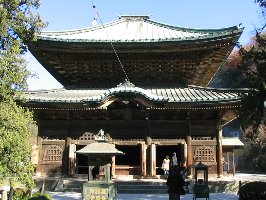
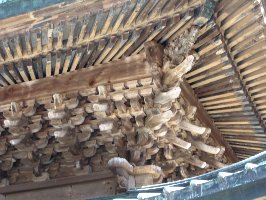
The present Butsuden Hall (仏殿, an Important Cultural Property) was constructed between 1624 and 1644 at Zojoji temple (増上, in Tokyo) and transferred here in 1647. On the ceiling and walls are traces of the one-time colorful paintings and ornaments of the Momoyama period (桃山時代, 1573-1603) style, which features elaborate construction and decorations. The main image is a five-meter (including pedestal) Jizo Bosatsu. The attendants, called Sentai Jizo (千体地蔵), literally, "One Thousand Jizo," actually number 282.
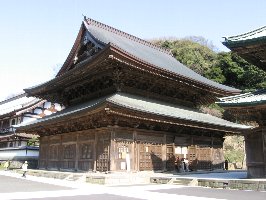
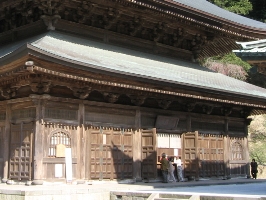
Hatto Hall (法堂, designated an Important Cultural Property by Kanagawa Prefecture), behind the Butsuden, was constructed in 1814 for Buddhist ceremonies. The main image is Senju Kannon (千手観音), literally, One-Thousand Armed Kannon. Above the entrance is a plaque inscribed Tokaihokutsu (東海法窟, literally, East Ocean Dharma Hall), written by a Chinese priest named Chikusai (竹西).
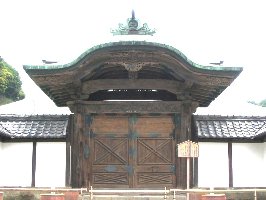
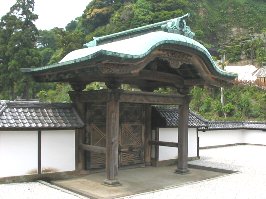
Further along the approach stands a Karamon Gate (唐門), which has a gently curved gable with elaborate carvings. The gate, like the Butsuden Hall, was transferred from Zojoji Temple.
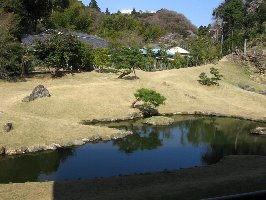
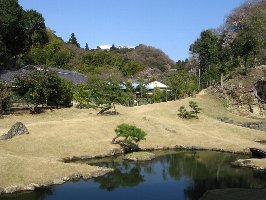
Ryuoden Hall (竜王殿) is a little further on. This building was brought here from Kyoto along with the Somon Gate. It houses a statue of Hokan Shaka (宝冠釈迦 Jewel-Crowned Shakyamuni). Behind the Ryuoden Hall lies a garden (designated a National Scenic Spot). The pond is in the form of the Chinese character "心", shin. A pond of this shape is called "shinji-ike," literally, a "shin-character pond," whose creation is credited to Daikaku Jenji.
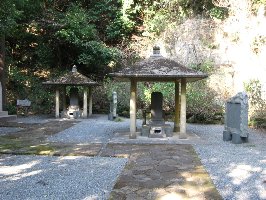
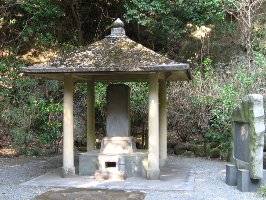
The path beside Ryuhoden runs upward beside a stream and then forks. The left path and a flight of stone steps lead to the grave of Kawamura Zuiken (川村瑞賢, 1617-99) and his son, Tsuken (通顯). Close by stands a monument to the memory of Zuiken and his great achievements.
A merchant in the early Edo period, Zuiken developed two new sea routes for transporting rice and other commodities from the Tohoku region to Edo and Osaka. One route connected ports on the eastern side of the Tohoku region and Choshi (銚子, in present-day Chiba Prefecture), while the other linked ports on the western side of Tohoku and Osaka via the Shimonoseki Strait (下関海峡).
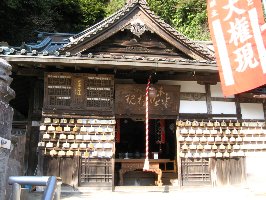
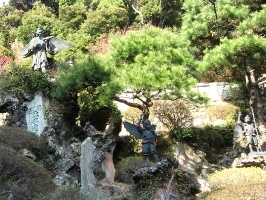
The other fork in the path goes further into the hillside, where a stone-paved approach and some flights of stone steps lead to a shrine. The surrounding hills, called Shojoken (勝上巘), are 114 meters above sea level. The hillside shrine, dedicated to Hansobo Daigongen (半僧坊大権現, a guardian deity of Kenchoji temple), was brought here from Shizuoka in 1890 by Ozora Kando (霄貫道).
Halfway up the steps and to the side are various tengu (天狗 long-nosed goblin) figures. The grounds offer a fine view of Kenchoji and the surrounding hills. A path to the right leads to a hiking trail that goes to Ten'en (天園), Kakuonji temple (覚園寺) and Zuisenji temple (瑞泉寺).
The grounds of Kenchoji used to contain two springs, Kinryusui (金竜水) and Furosui (不老水), which were counted among the five famous springs of Kamakura. Both are now extinct.
Temple Treasures: Kenchoji possesses many treasures. Some are occasionally on display at the Kokuhokan within the grounds of the Tsuruoka Hachimangu Shrine; others are shown during a three-day airing in early November.
One of the latter is a portrait (designated an Important Cultural Property) of Hojo Tokiyori, the fifth regent, depicted in the informal wear called kariginu (狩衣) and sashinuki (指貫). Another portrait (a National Treasure) is of Rankei Doryu, a celebrated priest. Among the many other temple possessions is calligraphy by Daikaku Zenji, a high-ranking priest. *Note: the kariginu was the upper part of the daily wear for noblemen and later for warriors, while the sashinuki was a kind of hakama (袴), a long ="all"ated skirt for men worn over a kimono.
Legend: Kajiwara-Segaki-e Rite (梶原施餓鬼会)
To understand the meaning of this rite, the reader should first know something about Bon (盆), sometimes referred to as ura-bon-e (盂蘭盆会), a Buddhist memorial service held from the 13th to the 15th of July (in August in some other areas) by relatives of the deceased.
During this period, most Buddhist temples hold a ceremony called segaki-e, (or segaki-kuyo, 施餓鬼供養 and sometimes simply osegaki, お施餓鬼, literally, "hungry ghosts' feeding rites").
At Kenchoji temple, after its annual segaki-e ceremony, a second ceremony called Kajiwara-Segaki-e is held under the Sammon Gate on July 15th. This is in memory of Kajiwara Kagetoki (梶原景時, ?-1200), a warrior of the Kamakura period.
Legend says that when Daikaku Zenji resided in the temple, he met a warrior who arrived just after the segaki-e ceremony had ended. The warrior regretted being late and was about to leave, but the priest called him back and conducted a special ceremony for him. The warrior thanked the priest for the service, saying, "I am the ghost of Kajiwara Kagetoki," and vanished. Ever since then, the temple has made it a custom to hold this additional ceremony immediately after the segaki-e.
A story surrounding the origin of the urabon-e goes back to ancient times in India, when Mokuren (目連), a disci="all" of Shakyamuni, wished to see what kind of life his deceased mother was leading. Shortly thereafter he had a dream in which he saw his mother suffering from hunger. In the dream, he offered her some food, but each time she reached for it, evil spirits blocked her way.
Upon awakening, Mokuren went to Shakyamuni and asked for his mercy. Shakyamuni replied that his mother's sins were too deep for her to be saved easily, and told Mokuren that to save her soul he should invite as many priests as possible and offer as much food as he could afford. Mokuren did as instructed, holding a memorial service for his mother and, according to this legend, thereby saved her hungry soul.
It should be noted, though, that a segaki-e ceremony was originally held at any time of need. In the course of time, however, the ceremony was incorporated into ura-bon-e, held in July or August. Both are connected with the concept of "feeding hungry souls."
Story: The Origin of Kenchin-jiru Stew (けんちん汁)
Kenchin-jiru is a type of stew made of vegetables first sauted in oil. The vegetables include sato-imo (a kind of taro), Japanese white radish, carrots, burdock, etc. Other ingredients are tofu, greens and just about anything else available. The dish is said to have been created by Daikaku Zenji, so that leftover vegetables and other food would be used right down to the last pieces. Because it originated at Kenchoji temple, it was kencho-jiru,, but over the years, the name eventually corrupted into kenchin-jiru.
| Meigetsuin temple (明月院) |
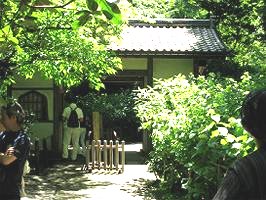
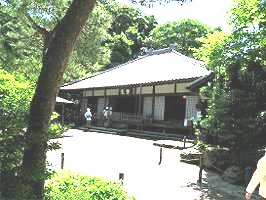
Full name:Fukugensan (福源山) Meigetsuin
Denomination:Rinzai Zen sect
Location:0.7 kilometers east-south-east from JR Kikatamakura Station.
History: Meigetsuin was added in the early Muromachi period as a sub-temple of Zenkoji temple (禅興寺). The latter, Zenkoji, had been built by Hojo Tokimune (北条時宗), who invited Rankei Doryu (蘭渓道隆) as the founding priest. Zenkoji was com="all"ted sometime between 1268 and 1269 and was counted as one of the ten prestigious temples in the Kanto region, Kanto jissatsu (関東十刹), under the Five Zen temples (鎌倉五山, Kamakura Gozan).
As the sub-temple of Zenkoji, Meigetsuin was built by Uesugi Norikata (上杉憲方, 1335-94) who nominated Misshitsu Shugon (密室守厳) as the founding priest. The name Meigetsuin was taken from the posthumous name of Norikata, and is said to be the founder of Yamanouchi branch of Uesugi family. After Zenkoji temple became extinct, Meigetsuin became independent in the early Meiji Period.
Grounds and structures:
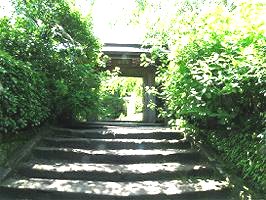
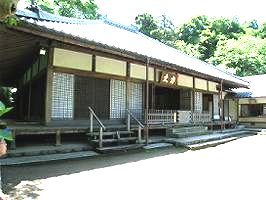
|
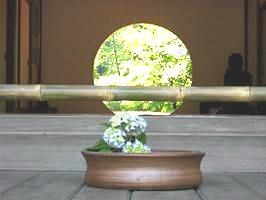
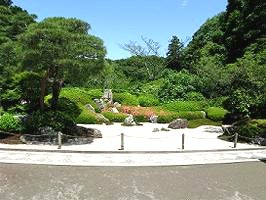
|
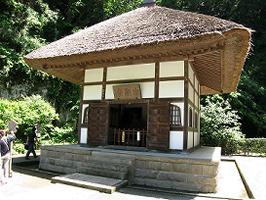
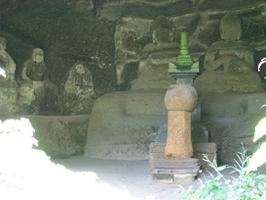
|
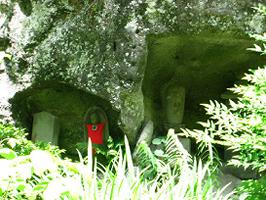
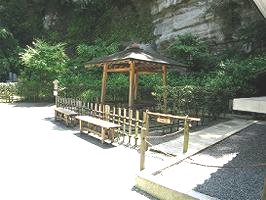
|
The temple treasures are not open to public view. Some of them are on loan to Kamakura Kokuhokan: a statue of Uesugi Shigefusa (上杉重房, thirteenth century), who was the founder of the Uesugi family in Kamakura; a statue of Hojo Tokiyori; an illustrated map of Meigetsuin; and a realistic statue of Gyokuin Eiyo. All the objects are designated Important Cultural Properties. The temple grounds are designated a Historic Site by the government.
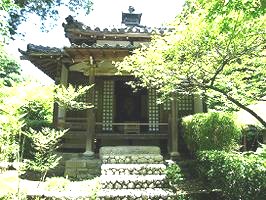
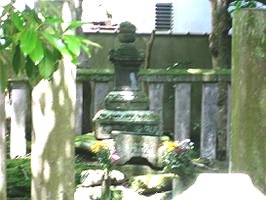
|
Tokiyori had Saimyoji temple (最明寺) built here, took the tonsure in 1256 after he retired from regency, and died in 1263. The temple, however, became extinct soon after his death. Thereafter, his son, Tokimune had a temple built, naming Zenkoji (aforementioned).
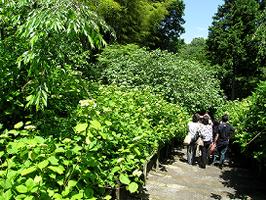
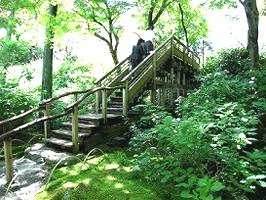
|
Story: There is a story that reveals an aspect of Tokiyori's character. He was also called Saimyoji Nyudo Tokiyori (最明寺入道時頼) in connection with Saimyoji temple which he had built. After Tokiyori retired from regency, he is said to have traveled across the country in the guise of a monk in order to see what conditions were like. (However, this fact is not clearly attested.)
One snowy day during his travel in present-day Gumma Prefecture, he stayed overnight at the home of a warrior called Sano Tsuneyo (佐野常世). As the host was poor and did not know who the guest was, the meal he served was very sim="all".
However, he welcomed his guest warmly. He took cherished trees from their planting pots, ume (梅, Japanese apricot), sakura (桜, cherry tree), and matsu (松, pine tree), in order to cook a meal and warm the room.
Tsuneyo said, "Because my land was taken away, I am hardly able to make ends meet. But, I keep my horse and a set of arms in good condition in case of emergency. When and if an emergency occurs," he continued, "I will be the first to rush to Kamakura to fight against any enemy to my last drop of blood."
Not long after this, the Kamakura government summoned retainers from across the country. Tsuneyo was the first to arrive. The man who granted him an audience was none other than the monk whom Tsuneyo had welcomed on that snowy night. Tokiyori commended his attitude and not only allowed him to regain his former land but gave him more.
This story is well known in the Noh theater as Hachinoki Monogatari (鉢の木物語), "The Tale of the Potted Trees." The phrase "Iza Kamakura (いざ鎌倉)," literally, "in an emergency" or "when it comes to the crunch, (I will rush to Kamakura as fast as possible)," finds its origin in this story.
| Chojuji temple (長寿寺) |
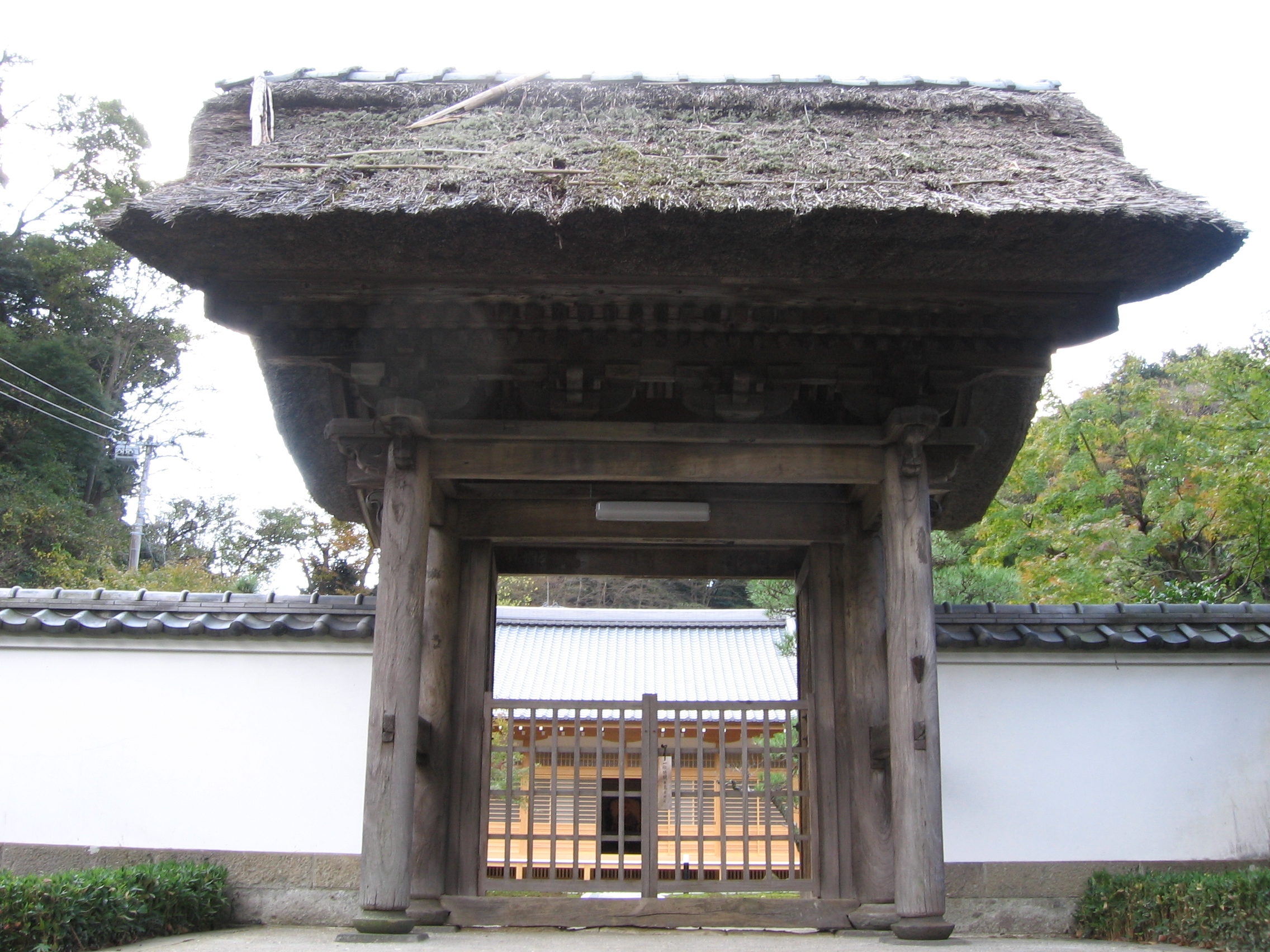
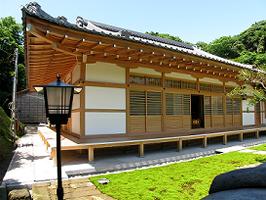
|
Denomination:Rinzai Zen sect
Location:0.9 kilometers south-east of JR Kikatamakura Station.
History: It was built between 1323 and 1336 by Ashikaga Motouji (足利基氏, 1340-67), the first Kamakura Kubo, in memory of his father, Ashikaga Takauji (足利尊氏, 1305-58). The founding priest was Kosen Ingen (古先印元). The characters, 長寿, part of the temple name, are said to have been taken from Takauji's posthumous name, 長寿寺殿, Chojujiden.
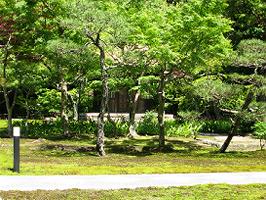
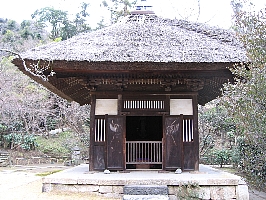
|
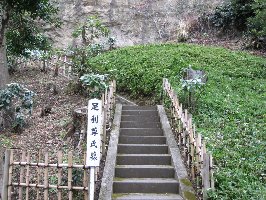
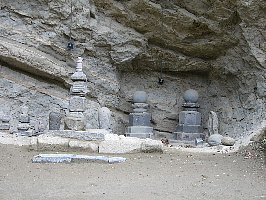
|
| Ennoji temple (円応寺) |
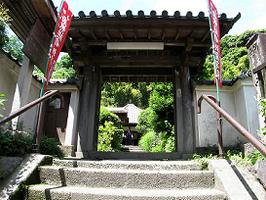
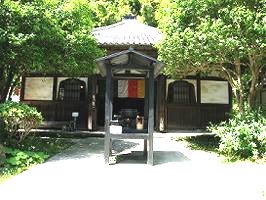
|
Denomination:Rinzai Zen sect
Location: 1.1 kilometers south-east of JR Kikatamakura Station.
History: It is said that originally the temple was only a hall called Arai Emmado (荒井(or 新居)閻魔堂) and was once located near Kuhonji temple (九品寺) in Zaimokuza (材木座). After the hall was destroyed by an earthquake and the resulting tidal wave, it was re-built here in 1704.
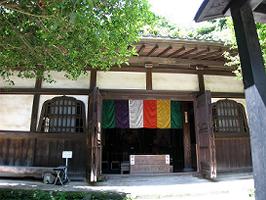
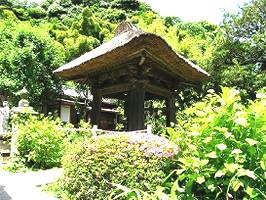
|
In the grounds are a square Main Hall in the center, the Kuri (庫裏) to the right, and a thatched belfry in front of the Kuri. The temple is popularly called Juodo (十王堂), because the Main Hall houses images of the Ten Kings, in addition to some other statues: The images of Ju-O (十王, Ten Kings in Hades or the nether world) consist of Emma Daio (閻魔大王 in the center as the main image), Shinko-O (秦広王), Shoko-O (初江王), Sotei-O or Sotai-O (宋帝王), Gokan-O (五官王), Hensei-o or Henjo-O (変性王), Taizan-O (太山王), Byodo-O (平等王), Toshi-O (都市王), and Godotenrin-O (五道転輪王).
Shoko-O is designated Important Cultural Properties. A macabre image, an Important Cultural Property by Kanagawa Prefecture, is a wooden Datsueba (奪衣婆), who robs the dead of their clothes at the dry riverbed of the river called Sanzu no Kawa River (三途の川, the River Styx).
The sculptures of Shoko-O, Gushojin (倶生神, a scribe who registers a person's conduct and informs Emma-Daio of it), Kisotsu (鬼卒, a demon soldier), Jinto-jo (人頭杖, a staff with two human heads) are now on loan to and displayed at Kokuhokan: the first and second images are designated Important Cultural Properties, while the third and the fourth are Important Cultural Properties by Kanagawa Prefecture.
The sculpture of Emma Daio is said to have been carved by Unkei (運慶, ?-1223), a celebrated sculptor of Buddhist images in the early Kamakura period.
Among his works are the Nio (仁王) sculptures in the Nandaimon Gate (南大門) of Todaiji temple and some works at Kofukuji (興福寺) in Nara. Unkei had a masculine and dynamic style that appealed to the warrior class in those days.
Story: There is a story about why and how Unkei made the image of Emma Daio here. He suffered a serious sickness and one day nearly died. One night he dreamed he went to Hell and after being interrogated by other kings stood before Emma Daio, who said to him, (I am rumored to be merciless because many peo="all" have been sentenced to fall into Hell. But the rumor is false. I am justice itself, for I judge fairly what one has done before death. Look closely at me," he continued, "and remember me well. I will return you to the world where you once lived, whereupon you are to carve my figure as realistically as possible and have it shown to all peo="all".( Upon hearing this, Unkei recovered from his illness.
The image here is the very one that he carved from memory. The one-and-a-half-meter-high image has a frightening red face with a swollen forehead, large eyes and a mouth opened wide.
The annual festivals are both held on the 16, one in January, the other in August, and attract many peo="all". The Emma is also called Kosodate Emma (子育て閻魔, "Child-Rearing Emma") because babies who are given their names here are said to grow strong and healthy.